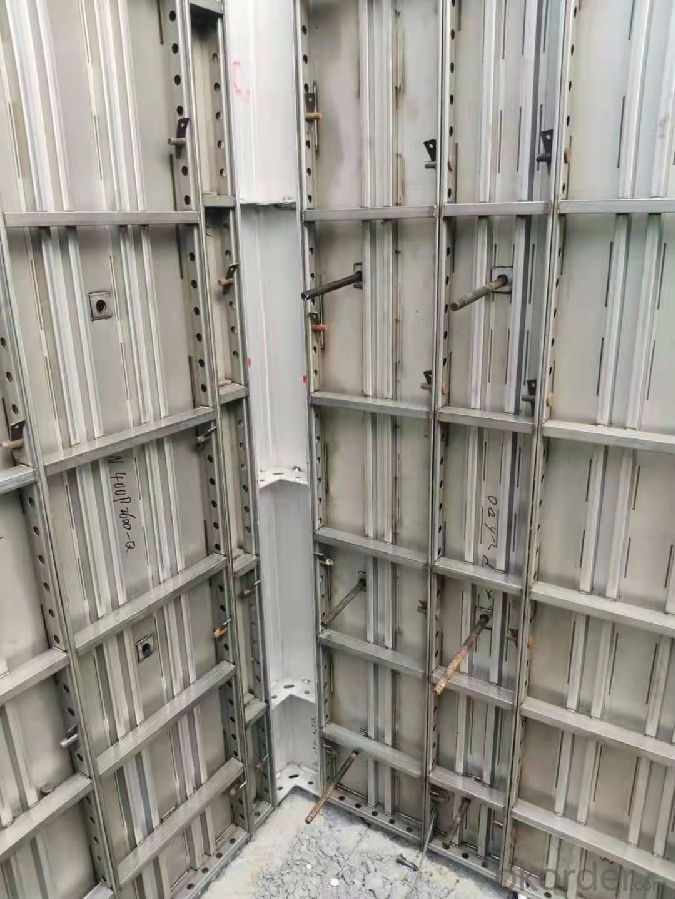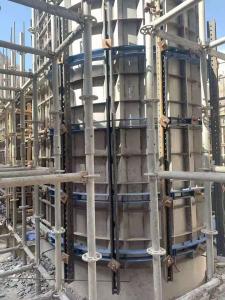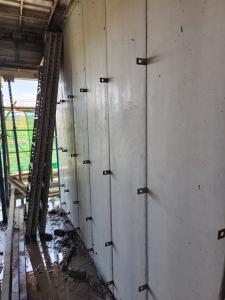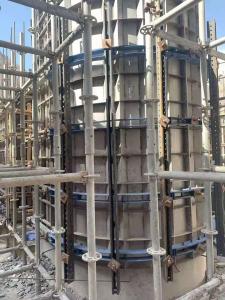Best qaulity of precast formwork,construction concrete column formwork, Stainless Steel Formwork
- Loading Port:
- Shanghai
- Payment Terms:
- TT or LC
- Min Order Qty:
- 1 set
- Supply Capability:
- 1000000 set/month
OKorder Service Pledge
OKorder Financial Service
You Might Also Like
Stainless steel formwork
Replaceable size aluminum formwork :400X1200mm , 400X1500mm
FORMWORK FOR building PROJECTS
modular panel formwork, for on-site concrete jobs where a fair-faced finish is required or where extremely high concrete pressures occur
The panels are made of a high-quality stainless steel frame and a top quality 5mm stainless steel sheeting. The sheet lies on top of the profiles so the joints between the panels are reduced to a very thin line.
Advantages:
1 Stainless steel formwork, 100% follow the design of aluminum alloy formwork system, it is interchangeable, compatible and can be used together with aluminum formwork at the same time .
2It is made of high-strength stainless steel strip by rolling and laser welding. It has good corrosion resistance and high density,is not easy to rust and has no fire hazard.
3Long service life, many turnover times, high recycling value
The number of turnovers is large, especially the characteristics of no dust, no need to brush or less mold release agent, and the characteristics of low renovation costs will bring unlimited optimistic prospects to it.



- Q:Can steel formwork be used for structures with high thermal insulation requirements?
- No, steel formwork is not typically used for structures with high thermal insulation requirements.
- Q:What are the different types of bracing used with steel formwork?
- The stability and strength of the structure being formed are ensured through the utilization of various types of bracing with steel formwork. Each type serves a specific purpose in achieving this goal. 1. Diagonal Bracing: To prevent lateral movement of the formwork and provide stability, diagonal braces are employed. These braces are typically positioned at an angle between two corners of the formwork, creating an "X" shape. They assist in evenly distributing loads and resisting the forces acting on the structure. 2. Vertical Bracing: In order to support the formwork vertically and prevent sagging or bulging, vertical braces are utilized. These braces are usually installed at regular intervals along the height of the formwork, offering additional support and rigidity to the structure. 3. Horizontal Bracing: Horizontal braces are implemented to counteract the horizontal forces acting on the formwork. They are placed horizontally, typically at the top and bottom of the formwork or at specific intervals along its length. This provides stability and prevents deformation caused by external loads. 4. Tension Rod Bracing: Tension rods are employed to distribute loads and reinforce the formwork. Depending on the specific requirements of the structure, these rods are typically installed diagonally or horizontally. Tension rod bracing is especially effective in resisting excessive deflection and preventing the formwork from collapsing under heavy loads. 5. External Bracing: When additional support is necessary, especially in the face of high wind loads or other external forces, external bracing is used. These braces are usually positioned on the outer side of the formwork and are designed to offer extra stability and prevent deformations caused by external factors. 6. Tie Rods: To hold the formwork together and apply uniform pressure on the structure, tie rods are employed. These rods are commonly installed horizontally or vertically and are tightened with nuts to secure the formwork in place. Tie rods also aid in evenly distributing loads across the formwork, preventing bulging or deformation. In summary, the different types of bracing utilized with steel formwork play a vital role in ensuring the stability, strength, and integrity of the structure being formed. They work collectively to resist external forces, distribute loads evenly, and prevent deformations or failures during the construction process.
- Q:Is steel formwork suitable for projects with high concrete strength requirements?
- Yes, steel formwork is suitable for projects with high concrete strength requirements. Steel formwork is known for its high strength and durability, making it ideal for projects that require high concrete strength. It can withstand the pressure and weight of the concrete, ensuring that it maintains its shape and stability during the pouring and curing process. Additionally, steel formwork provides a smooth and uniform finish to the concrete, which is important for achieving high strength and quality in the final product. Moreover, steel formwork can be easily reused multiple times, making it a cost-effective option for projects with high concrete strength requirements.
- Q:What are the different types of reinforcement used in steel formwork systems?
- Steel formwork systems utilize various types of reinforcement to enhance the structural integrity and durability of concrete structures, each serving a specific purpose. 1. Rebars, also known as steel bars, are commonly employed in steel formwork systems to provide tensile strength to the concrete. These bars are positioned in the formwork prior to pouring the concrete, effectively preventing cracking and ensuring structural stability. 2. Wire mesh reinforcement, consisting of interconnected steel wires welded or woven together, is another frequently used type in steel formwork systems. Its purpose is to evenly distribute loads across the concrete, thereby improving its strength and reducing the risk of cracking. 3. Steel fibers, discrete reinforcing elements, are often incorporated directly into the concrete mix. These fibers enhance the concrete's tensile strength, making it more resistant to cracking and enhancing overall durability. Steel fibers are especially valuable in scenarios where traditional reinforcement methods may be challenging to implement. 4. Stirrups and ties, made of steel bars, are commonly employed in reinforced concrete structures and are also integrated into steel formwork systems. They secure the main reinforcement bars in place and provide additional support to the structure. Stirrups and ties prevent rebars from shifting or bending during concrete placement, ensuring proper alignment and spacing. 5. Steel plates and brackets are utilized in formwork systems to bolster support and stability. These elements are typically affixed to the formwork panels, acting as reinforcement mechanisms that distribute loads and prevent deformation or failure. Collectively, the various types of reinforcement used in steel formwork systems play a crucial role in guaranteeing the strength, stability, and longevity of concrete structures. They work in unison to withstand external forces, prevent cracking, and enhance overall structural performance.
- Q:How does steel formwork impact the overall construction cost?
- Steel formwork is a popular choice in the construction industry due to its durability, versatility, and reusability. When considering the impact of steel formwork on overall construction cost, several factors should be taken into account. Firstly, steel formwork offers a longer lifespan compared to traditional timber formwork, reducing the need for frequent replacements. This longevity leads to cost savings as the initial investment in steel formwork can be spread across multiple construction projects, eliminating the need for continuous purchases of new formwork materials. Additionally, steel formwork is known for its superior strength and stability. It can withstand higher concrete pressures, allowing for taller and more complex structures to be constructed. This enables builders to maximize floor space and increase the overall efficiency of a project, ultimately reducing construction time and costs. Moreover, steel formwork provides a smooth and consistent finish to concrete surfaces, resulting in less need for additional finishing work. This reduces labor costs and the time required for subsequent trades to commence their work, contributing to overall cost savings. Furthermore, steel formwork is designed to be easily assembled and disassembled, enabling faster construction processes. This efficiency translates into reduced labor costs and shorter project durations, ultimately impacting the overall construction cost. However, it is worth noting that the initial investment in steel formwork can be higher compared to other formwork materials such as timber or aluminum. Nevertheless, the long-term benefits and potential cost savings associated with steel formwork outweigh this initial expense. In conclusion, steel formwork positively impacts the overall construction cost by providing durability, reusability, and efficiency. Its longer lifespan, strength, and ease of use contribute to cost savings through reduced material replacements, shorter project durations, and minimized finishing work. Despite the higher initial investment, the numerous advantages of steel formwork make it a cost-effective choice for construction projects.
- Q:Is steel formwork suitable for projects with limited skilled labor?
- Yes, steel formwork is suitable for projects with limited skilled labor. Steel formwork is a pre-fabricated system that can be easily assembled and dismantled, making it user-friendly even for unskilled laborers. It does not require extensive training or specialized skills to work with steel formwork. Additionally, steel formwork is highly durable and can be reused multiple times, providing cost-effectiveness and reducing the need for skilled labor throughout the project. The strength and stability of steel formwork also ensure accurate and precise construction, even with limited skilled labor. Therefore, steel formwork is a suitable choice for projects where skilled labor is limited, as it allows for efficient and reliable construction without compromising the quality of the project.
- Q:How does steel formwork handle concrete curing additives?
- Steel formwork is a popular choice for concrete construction due to its durability and strength. When it comes to handling concrete curing additives, steel formwork is highly compatible and can effectively accommodate the use of such additives. Concrete curing additives, such as accelerators or retarders, are used to modify the setting and hardening time of concrete. These additives are typically added to the concrete mixture during the mixing process or applied to the surface of the formwork before pouring the concrete. Steel formwork is not adversely affected by the presence of curing additives in the concrete. It is resistant to chemical reactions and can withstand the potentially corrosive nature of certain additives. This ensures that the steel formwork remains structurally sound and maintains its integrity throughout the concrete curing process. Furthermore, steel formwork offers a smooth and non-porous surface, which allows for easy application and penetration of curing additives. This facilitates the even distribution of additives across the concrete surface, promoting consistent curing and optimal strength development. Moreover, steel formwork is reusable, which means that it can be used for multiple concrete pours. This reusability factor is particularly advantageous when working with concrete curing additives, as the formwork can be easily cleaned after each use, ensuring that no residue or build-up of additives remains on the surface. This helps to prevent any potential interference with subsequent concrete pours or compromising the quality of the cured concrete. In summary, steel formwork is well-suited for handling concrete curing additives. Its chemical resistance, smooth surface, and reusability make it an ideal choice for accommodating the use of curing additives, ensuring efficient and effective concrete curing.
- Q:How does steel formwork affect the overall constructability of the structure?
- The overall constructability of a structure is greatly enhanced by the use of steel formwork. Firstly, the high strength and durability of steel formwork enable it to withstand the pressure and forces exerted during the concrete pouring and curing process. This strength allows for the construction of taller and more complex structures, providing greater design flexibility. Furthermore, the reusability of steel formwork significantly reduces construction time and costs. Unlike traditional wooden formwork, steel formwork can be easily dismantled, cleaned, and reassembled for future concrete pours. This eliminates the need for continuous formwork fabrication, resulting in faster construction cycles and increased productivity. In addition, steel formwork ensures excellent dimensional accuracy and stability. The rigid structure of steel formwork allows for precise pouring and shaping of concrete according to desired dimensions, resulting in a more accurate and seamless end product. This accuracy is particularly important for high-quality construction, especially in critical elements such as walls, columns, and beams. Moreover, steel formwork offers superior surface finishes and better concrete quality. Its smooth and non-absorbent surface prevents water leakage or seepage from the concrete, resulting in a higher-quality finish. This is particularly beneficial for structures that require high aesthetic appeal or exposed concrete surfaces. Lastly, steel formwork enhances safety on construction sites. Its robust structure and stability reduce the risk of accidents during the concrete pouring and formwork removal processes. Steel formwork also allows for easier access and movement of workers, ensuring safe and efficient task performance. In conclusion, steel formwork significantly improves the constructability of structures. Its strength, reusability, dimensional accuracy, surface finish, and safety benefits make it a preferred choice for construction projects. By utilizing steel formwork, construction processes become more efficient, cost-effective, and reliable, resulting in a higher-quality end product.
- Q:What are the different types of steel formwork joints and connections?
- There are several types of steel formwork joints and connections that are commonly used in construction. These include: 1. Butt joint: This is the most basic type of joint where two formwork panels are placed side by side and connected with bolts or clamps. It is a simple and quick method of joining formwork panels. 2. Lap joint: In a lap joint, two formwork panels overlap each other, and are connected with bolts or clamps. This type of joint provides more strength and stability compared to a butt joint. 3. Corner joint: Corner joints are used to connect formwork panels at right angles, such as in the corners of a wall or column. They can be formed by overlapping the panels or using special corner connectors. 4. T-joint: T-joints are formed when three formwork panels intersect at a right angle, with one panel acting as the stem of the "T". These joints are commonly used in the construction of beams or slabs. 5. Hinged joint: Hinged joints are used when formwork panels need to be connected at an angle that can be adjusted. This type of joint allows for flexibility in formwork assembly and alignment. 6. Wedge joint: Wedge joints are formed by inserting wedges into pre-cut slots or grooves in the formwork panels. This type of joint provides a secure and tight connection between the panels. 7. Tie rod joint: Tie rod joints are used to connect formwork panels through the use of threaded steel rods. These joints are commonly used in large-scale construction projects where formwork needs to withstand high loads. 8. Pin joint: Pin joints are formed by inserting steel pins into pre-drilled holes in the formwork panels. This type of joint provides a rigid connection between the panels. Each type of joint or connection has its own advantages and is selected based on the specific requirements of the construction project. The choice of joint type will depend on factors such as the load-bearing capacity, formwork design, and ease of assembly and disassembly.
- Q:How does steel formwork contribute to the overall strength and stability of a structure?
- The construction industry heavily relies on steel formwork to enhance the strength and stability of structures. This crucial component plays a vital role in maintaining the integrity and durability of buildings by providing a dependable support system during the process of pouring concrete. To begin with, steel formwork possesses exceptional strength and rigidity, enabling it to withstand the immense weight and pressure exerted by wet concrete. Its sturdy construction ensures that it does not deform or collapse under these heavy loads, thereby preventing any potential damage or compromise to the stability of the structure. Furthermore, steel formwork provides an accurate and precise framework for pouring concrete. The dimensional stability of steel ensures that the formwork retains its shape and dimensions throughout the construction process. This accuracy is crucial in achieving a structurally sound and level structure, as any misalignment or irregularity in the formwork can lead to uneven distribution of concrete and weaken the overall strength of the building. Moreover, steel formwork exhibits excellent resistance to moisture and corrosion. This resistance guarantees that the formwork remains intact and structurally sound, even in environments with high humidity or exposure to water. By preventing rust and deterioration, steel formwork maintains its strength and stability over time, thus contributing to the long-term durability of the structure. Another notable advantage of steel formwork is its reusability. Unlike traditional wooden formwork, steel formwork can be reused multiple times without compromising its structural integrity. This reusability not only reduces construction costs but also minimizes waste and environmental impact. The ability to reuse steel formwork ensures that subsequent concrete structures maintain consistent strength and stability, without any compromise in quality. In conclusion, steel formwork is an indispensable element in the construction industry, significantly enhancing the strength and stability of structures. Its exceptional strength, dimensional accuracy, resistance to moisture and corrosion, and reusability make it an ideal choice for ensuring the integrity and durability of concrete structures. By providing a robust and reliable support system, steel formwork plays a pivotal role in the construction of safe and long-lasting buildings.
1. Manufacturer Overview |
|
|---|---|
| Location | |
| Year Established | |
| Annual Output Value | |
| Main Markets | |
| Company Certifications | |
2. Manufacturer Certificates |
|
|---|---|
| a) Certification Name | |
| Range | |
| Reference | |
| Validity Period | |
3. Manufacturer Capability |
|
|---|---|
| a)Trade Capacity | |
| Nearest Port | |
| Export Percentage | |
| No.of Employees in Trade Department | |
| Language Spoken: | |
| b)Factory Information | |
| Factory Size: | |
| No. of Production Lines | |
| Contract Manufacturing | |
| Product Price Range | |
Send your message to us
Best qaulity of precast formwork,construction concrete column formwork, Stainless Steel Formwork
- Loading Port:
- Shanghai
- Payment Terms:
- TT or LC
- Min Order Qty:
- 1 set
- Supply Capability:
- 1000000 set/month
OKorder Service Pledge
OKorder Financial Service
Similar products
New products
Hot products


























